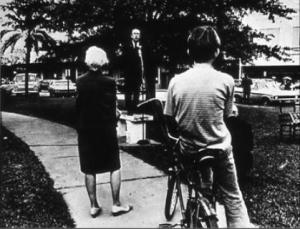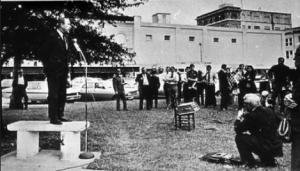History of Buddhism
The goal of Buddhism is to reach enlightenment, but the way to reach enlightenment is extremely complicated and has many different forms. As the religion grew and spread across India, then East Asia, then China and finally Japan, the religion changed and incorporated new ideas, but the ultimate goal is to reach nirvana though.
Buddhism was first introduced into India. Shaka, Buddhist priest, was born and became a great leader. Maya, queen and mother, had a revelation of a great leader being born and as it happens, the great leader was her son. Shaka’s father wanted him to be a great prince and to be sheltered from the world.
One night, the prince decided to sneak out of the palace and encountered four signs. The first one was a sick man, the second was an old man, the third was a religious man, and the last was a dead man. Shaka was very moved by the four signs and discovered how much suffering there was in the world. He decided that religion was the solution to all of suffering.
Shaka decided to leave the palace and become a religious man. This was known as “The Great Departure.” He studied for many years with different teachers and discovered the great dilemma of human life is suffering.
Shaka left his teachers and decided to sit under a tree until he achieved enlightenment. He discovers there is good and bad karma in the world, and when a person is good they are reborn into a better life and if they are bad, the person is reborn into a worse life. The main goal, according to Shaka, is to break the chain of reincarnation and to reach enlightenment.
Buddhism did not just bring a new religion to the world, but beautiful sculptures. As the years progressed, the Buddha’s changed and different forms were created. Also depending on the region, the Buddha’s were different. In the Middle East, Buddha’s had less clothing than the ones in Asia, but overall they were all beautiful.
Ethics in Photography
The preamble of the NPPA Code of Ethics says that photojournalists operate as trustees of the public. Their primary role is to report visually on the significant events and varied viewpoints on our common world. Their primary goal is the faithful and comprehensive depiction of the subject at hand. As photojournalists, they have the responsibility to document society and to preserve its history through images. Photographic and video images can reveal truths, expose wrong doings and neglect, inspire hope and understanding, and connect people around the globe through the language of visual understandings. Photographs can also cause great harm if they are callously intrusive or are manipulated.
The code says photojournalists must:
- Be accurate and comprehensive in the representation of subjects.
- Resist being manipulated by stage photo opportunities.
- Be complete and provide context when photographing or recording subjects. Avoid stereotyping individuals and groups. Recognize and work to avoid presenting one’s own biases in the work.
- Treat all subjects with respect and dignity. Give special consideration to vulnerable subjects and compassion to victims of crime or tragedy. Intrude on private moments of grief only when the public has an overriding and justifiable need to see.
- When photographing subjects do not intentionally contribute to, alter, or seek to alter or influence events.
- Editing should maintain the integrity of the photographic images’ content and context. Do not manipulate images or add or alter sound in any way that can mislead viewers or misrepresent subjects.
- Do not pay sources or subjects or reward them materially for information or participation.
- Do not accept gifts, favors, or compensation from those who might seek to influence coverage.
- Do not intentionally sabotage the efforts of other journalists.
Photographers need to keep this code of ethics in mind when they are photographing different subjects, so they can be creditable with their job. Photographers need to be sensitive to the subject matter and keep in mind the individuals when they are photographing.
Images such as Jack Ruby shooting Lee Harvey Oswald, brings up some ethical issues. The photograph displays Oswald’s death, and this photograph was shocking to viewers who saw it and witnessed the crime.
Another problematic image was Senator Henry Jackson campaigning for president. The photographer shot the photograph in a way that it seemed only a few people showed up to his campaign speech. In reality, a lot of people showed up and the camera angle misrepresented the situation. The photojournalist was not acting fair, and obviously did not favor Jackson as the president.

Jackson Campaigning

Same Photo BUT Different Angle
Compositional Elements to Photography
When photographing, the photographer must keep in mind a couple of elements to create exceptional photographs. Some of these elements include lighting situations, rule of thirds, and composition.
There are four properties that deal with lighting. The first one is intensity, which refers to the amount of light hitting the subject matter. The second is the direction of light. Some common directions of light are front, top, side, under, and back lighting. Each produces a different effect, depending of the photographs subject matter. The third is quality of light. There are two types of quality of light which includes diffused light and hard light. Diffused light is multi-directional lighting, while hard light comes from a single light source. The last property is color.
The rule of thirds is a simple rule that photographers use to create better photographs. The rule of thirds is simply imaginary lines that divide a photograph into thirds both horizontally and vertically. A photographer places the most important parts of the photograph where the lines intersect.
The last element that is important to photographers is composition. One important element to composition is filling the frame. Often less experienced photographers perceive objects in the view finder larger than they actually are. This causes a lot of wasted space in the photograph, which could take away from the composition trying to be achieved. Another important element to pay attention to when speaking about composition is ‘slight’ distractions that can appear in a photo. Sometimes things are growing out of a subjects head, or something is crossing the background of the photograph that distracts the view. The photographer has to be mindful and pay close attention to what they are photographing. Always double check what is in the foreground, middle ground, and background of a photograph.
Modern Sculpture Artists
One of the most interesting art history classes I have taken is Topics in Modern Art. The class focuses on modern sculpture, starting around the 19th century with Rodin and working up to the 21st century with Christo and Jean-Claude.
Some of Rodin’s most famous pieces are “Age of Bronze,” “The Gates of Hell,” “The Thinker” and my favorite, “The Kiss.” When the piece was displayed, the critics didn’t understand the pose. They didn’t know why Rodin decided to have the hand of the sculpture resting on top of the head. The critics also created allegations against Rodin, stating that he casted from a live model instead of creating it by hand alone. The accusations were entirely false and Rodin never casted from live models.
It is my favorite piece because it is so intimate. Rodin entangled the two lovers together in such a way that the viewer can feel their love and passion for each other. It is quite an amazing effect that Rodin is able to accomplish. Another artist that had a similar idea to Rodin’s “The Kiss,” is Brancusi’s “Kiss.” This is a much more simplified version of Rodin piece, but has just as much meaning. Some say that Brancusi’s piece is much more intimate than Rodin’s because the sculpture is much closer together. My personal opinion is Rodin’s piece is more intimate than Brancusi’s. The detail is astonishing and makes the viewer feel there are experiencing a very intimate moment that usually is not shown in public.
Two other modern sculpture artists that I am very fond of are Christo and Jean-Claude. They are most famous for their unique technique of wrapping. Wrapping essentially is taking miles of fabric and literally wrapping it around a certain landscape. The reason Christo and Jean-Claude wrap different landscapes is because they want viewers to interpret the landscape they wrapped in a different way. Their most recent wrapping project was in Central Park in New York City called “The Gates.” They came up with the idea in 1979 and finished it in 2005. Another famous wrapping the created was Pont Neuf in Paris. The project was started in 1975 and finished it in 1985. There work is so amazing with the scale of the projects they take on and the idea.
I find Christo and Jean-Claude’s work very inspirational and unique compared to other artists in the 21st century. They have discovered a new medium of art that is very beautiful and fun to experience. There has been some speculation of a new piece of work that will be displayed in the summer of 2013 on the Arkansas River near Cañon City, Colorado. The piece is called “Over the River” and hopefully I will be able to experience this new fascinating instillation.






